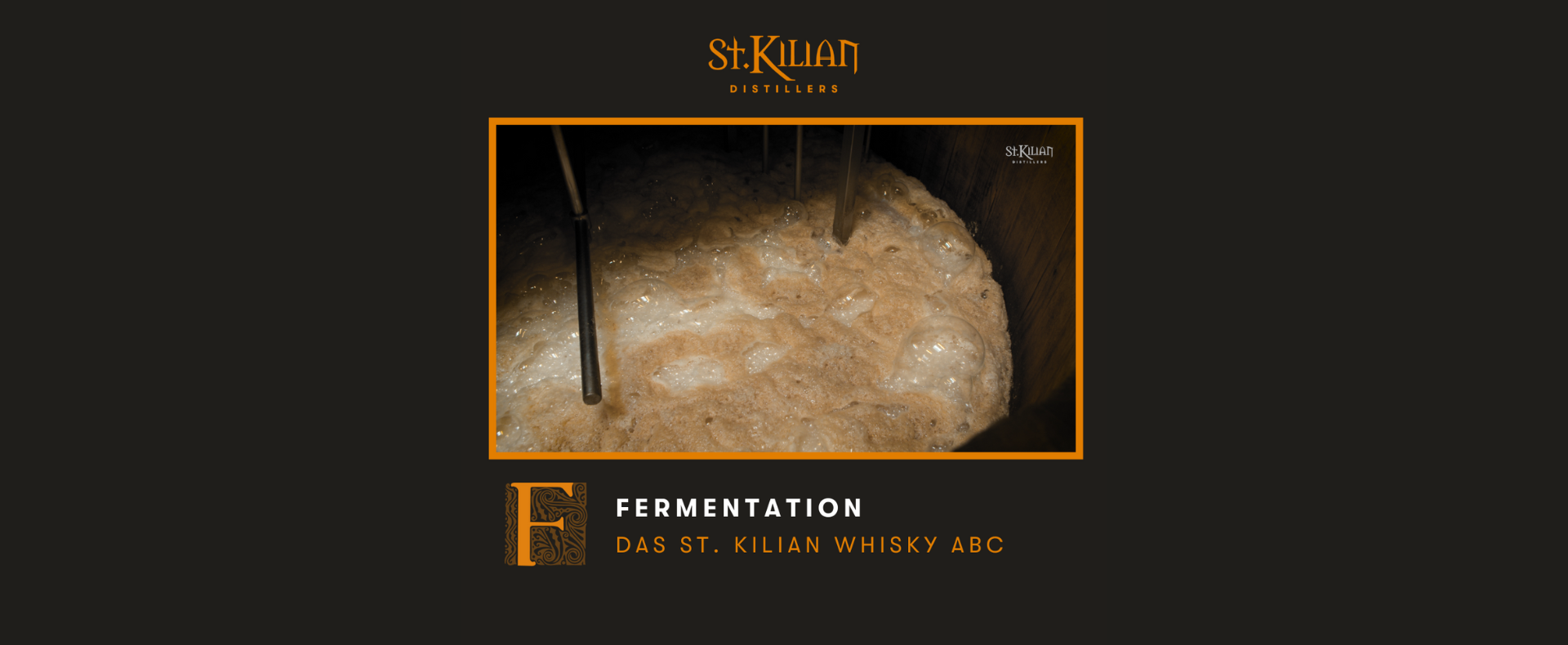F - like fermentation

What is fermentation?
Fermentation is a biological process in whiskey production in which the sugars contained in the wort are converted into alcohol (ethanol) by yeast. The term comes from Latin(fermentum) and translated means "fermentation".
What are yeasts?
Yeasts belong to the class of tubular fungi (ascomycetes), which are one of the large divisions in the kingdom of fungi. They are unicellular microorganisms, so they consist of only one cell. The most commonly used yeast for the fermentation of beer, wine and whiskey is Saccharomyces cerevisiae.
Where does the fermentation take place?
Fermentation, i.e. alcoholic fermentation, takes place at St. Kilian Distillers in the wooden washbacks. These 10,800-liter fermentation vats made of Douglas fir wood are filled with the sugary wort obtained after mashing and lautering, and the required amount of M1 dry yeast is added during this process.
How does the yeast work?
The biological purpose of yeast is to divide - and for this it needs energy. It obtains this by metabolizing sugars contained in the wort. The yeast's energy production can take place both by respiration and by fermentation. Indeed, yeast is the only living microorganism capable of metabolizing sugars both in the presence of oxygen (aerobic conditions) and in its exclusion (anaerobic conditions).
What happens in the presence of oxygen?
In the presence of oxygen, i.e. during respiration, yeasts thrive magnificently. They "metabolize" sugar completely to carbon dioxide and water, thereby gaining the energy they need for division and the construction of new cells. Under these aerobic conditions, 38 molecules of the energy molecule adenosine triphosphate (ATP), which is important for cells, are produced from one molecule of the fermentable sugar glucose.
What happens in the absence of oxygen?
After the yeast has consumed the oxygen dissolved in the wort, but usually much earlier, it switches its metabolism to fermentation. Under these anaerobic conditions, the yeast consumes considerably more sugar molecules to compensate for the energy losses. This is because during fermentation the glucose is incompletely converted to carbon dioxide and ethanol with the formation of only two molecules of ATP.
How long does the fermentation last?
After the temporally different phases of fermentation - orientation phase, growth phase and stationary phase - the lack of nutrients and the increasing alcohol concentration in the wash ultimately lead to the death of the yeast cells. At this point, about 40 to 48 hours have passed. At St. Kilian Distillers, alcoholic fermentation takes an average of 70 hours, with a minimum of 65 hours.
What influence do bacteria have?
After the yeast has died, fermentation is not yet over. Bacteria and wild yeasts, which find shelter in the microscopic irregularities of the washback staves, can metabolize the contents of the dead and decayed yeast cells and any remaining sugars in order to grow and multiply. These microbes, which are mainly acetic and lactic acid bacteria, produce chemical compounds such as acetic acid and lactic acid during their metabolism, which are released into the wash.
At what temperature is the fermentation carried out?
Typically in Scotland, the wort is cooled to a pitching temperature of 16°C to 19°C before the yeast is added. Since heat is also produced during fermentation, the temperature in the washbacks rises steadily. Our four fermentation vats are each equipped with two cooling plates. This is a special feature not found in Scottish distilleries, for example. We initially start at a temperature of 28°C and then maintain a constant fermentation temperature of 31.5-32.0°C. This creates the optimal working conditions for our yeast to form the appropriate yield of ethanol as well as the flavors we desire.
What flavors are formed during fermentation?
Fermentation is also known as the birth of whiskey. This is because it is here that not only the drinking alcohol ethanol is produced for the first time, but also a large number of chemical compounds which, with their floral, fruity, grassy, soapy, oily, sulfurous and waxy aromas and flavors, help to shape the aroma of the later whiskey. Among them are:
- Glycerol and derivatives, such as glycerides
- Ethyl acetate and other esters
- Organic acids, including acetic acid, lactic acid
- Fatty acids and fatty acid esters
- Medium and higher alcohols, so-called fusel oils: first and foremost isoamyl alcohol and phenethyl alcohol
- Phenolic compounds
- Sulfur compounds with their usually unpleasant aromas
- Aldehydes with their grassy and often pungent aromas
- Keto compounds, including diketones: first and foremost the butterscotch-scented diacetyl